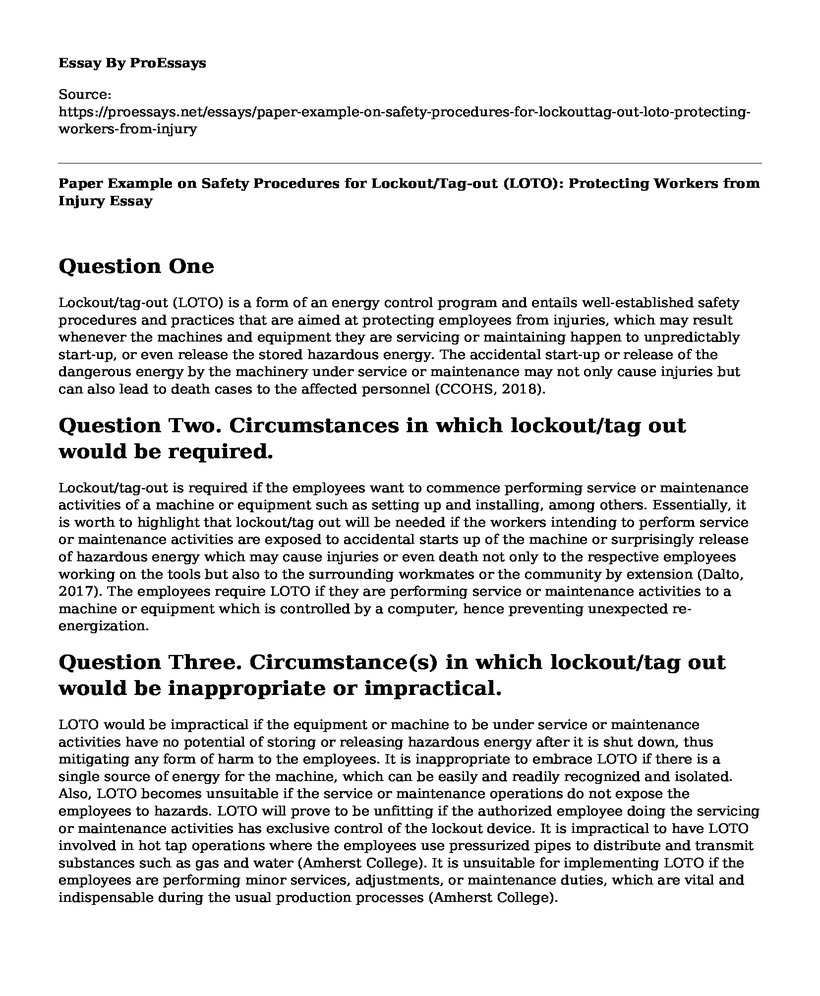Question One
Lockout/tag-out (LOTO) is a form of an energy control program and entails well-established safety procedures and practices that are aimed at protecting employees from injuries, which may result whenever the machines and equipment they are servicing or maintaining happen to unpredictably start-up, or even release the stored hazardous energy. The accidental start-up or release of the dangerous energy by the machinery under service or maintenance may not only cause injuries but can also lead to death cases to the affected personnel (CCOHS, 2018).
Question Two. Circumstances in which lockout/tag out would be required.
Lockout/tag-out is required if the employees want to commence performing service or maintenance activities of a machine or equipment such as setting up and installing, among others. Essentially, it is worth to highlight that lockout/tag out will be needed if the workers intending to perform service or maintenance activities are exposed to accidental starts up of the machine or surprisingly release of hazardous energy which may cause injuries or even death not only to the respective employees working on the tools but also to the surrounding workmates or the community by extension (Dalto, 2017). The employees require LOTO if they are performing service or maintenance activities to a machine or equipment which is controlled by a computer, hence preventing unexpected re-energization.
Question Three. Circumstance(s) in which lockout/tag out would be inappropriate or impractical.
LOTO would be impractical if the equipment or machine to be under service or maintenance activities have no potential of storing or releasing hazardous energy after it is shut down, thus mitigating any form of harm to the employees. It is inappropriate to embrace LOTO if there is a single source of energy for the machine, which can be easily and readily recognized and isolated. Also, LOTO becomes unsuitable if the service or maintenance operations do not expose the employees to hazards. LOTO will prove to be unfitting if the authorized employee doing the servicing or maintenance activities has exclusive control of the lockout device. It is impractical to have LOTO involved in hot tap operations where the employees use pressurized pipes to distribute and transmit substances such as gas and water (Amherst College). It is unsuitable for implementing LOTO if the employees are performing minor services, adjustments, or maintenance duties, which are vital and indispensable during the usual production processes (Amherst College).
Question Four. Workplace parties who would have lockout/tag out responsibilities.
Different parties, such as the management, authorized employees, and supervisors, among others, have duties towards lockout/tag out. The management is supposed to draft, review, and adjust the written practices and procedures entailed in the LOTO program. The administration must provide the needed resources such as appliances, and protective equipment to facilitate effective implementation of the plan (CCOHS, 2018). The management should perform conformance to LOTO through period monitoring and measurement. Supervisors are supposed to make sure that the workers under their authority are continuously following and practicing the established lockout/tag-out procedures. The supervisors must ensure that only the adequately trained and authorized employees that perform maintenance or servicing activities required in LOTO (CCOHS, 2018). The authorized employees have the responsibility of implementing the established LOTO procedures. Nonetheless, the authorized employees have the mandate of reporting any emerging issue they encounter or identify it as an obstacle to effective implementation of the lockout/tag-out program (CCOHS, 2018).
References
Amherst College. (n.d). Lock-Out / Tag-Out Policy. Retrieved from https://www.amherst.edu/offices/enviro_health_safety/safety/lockout_tagout
Canadian Centre for Occupational Health and Safety (CCOHS). (2018). OSH Answers Fact Sheets: lockout/tag out. Governement of Canada. Retrieved from https://www.ccohs.ca/oshanswers/hsprograms/lockout.html
Dalto, J. (2017). LOTO Safety: The 6 Steps of Lockout/Tagout. Convergence Training. Retrieved from https://www.convergencetraining.com/blog/loto-safety-6-steps-of-lockout-tagout
Cite this page
Paper Example on Safety Procedures for Lockout/Tag-out (LOTO): Protecting Workers from Injury. (2023, Feb 23). Retrieved from https://proessays.net/essays/paper-example-on-safety-procedures-for-lockouttag-out-loto-protecting-workers-from-injury
If you are the original author of this essay and no longer wish to have it published on the ProEssays website, please click below to request its removal:
- Case Study Example: A Social Work Student's Interview With the Client
- Horizon Medical Billing and Coding Case Analysis
- What Is the Best Way for College Students to Balance Work, Studying, Classes and Social Life? - Essay Sample
- Essay on Face Negotiation: Ting-Toomey Theory for Conflict Resolution
- Essay Example on Dream Big, Aim High: My Path to Becoming a CPA and CFP
- Essay Sample on Maintaining Professional Relationship for Counseling: Ethical & Cultural Factors
- Motivating Professionals: Expectancy Theory & Similarities - Essay Sample







